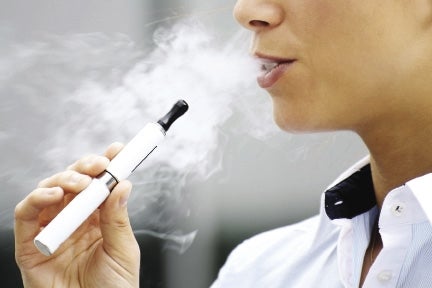Tobacco age hikes spread but are teens safe?
 The discussion about smoking extends to e-cigarettes.
The discussion about smoking extends to e-cigarettes.
Long gone are the days when the movies and the Marlboro man tricked people into thinking smoking was for the free-spirited and glamourous. This generation’s teenagers have been brought up knowing that tobacco use obliterates the lungs and leads to a lifetime of health problems.
Over the past few years, however, a new kind of poison has complicated matters. National data show that use of e-cigarettes, vaporizers and other electronic nicotine delivery systems, marketed as flavored, fun and less toxic than cigarettes, is on the uptick among high schoolers. As more local and state governments look into raising the cigarette purchasing age from 18 to 21, restricting the use of electronic nicotine delivery systems is part of the overall strategy. Several Central Massachusetts and MetroWest towns have passed their own ordinances bumping the tobacco purchasing age to 21, as the state legislature considers a similar measure.
The idea is that by raising the age by just three years, the high school population will be closer to being iced out of the smoking world altogether. Dr. Douglas Waite, chief medical officer at Saint Vincent Hospital in Worcester, said the younger people are when they start smoking, the harder it becomes for them to overcome an addiction later on in life. Raising the tobacco purchasing age could make it more difficult for teenagers to access those products, he said.
“Added exposure over one’s lifetime increases the risks to a whole host of cancers and health problems,” Waite said.
Tobacco 21 in Massachusetts
Needham was the first town in the state to implement a tobacco purchasing age of 21. When the town council passed an ordinance back in 2005, it was more of an experiment than anything else, said Dr. Rob Crane, president of the Preventing Tobacco Addiction Foundation, an advocacy group.
“Because Needham is [small], I thought ‘Well, that’s a pretty useless regulation.’ You can get on a bike and be in Dedham in five minutes,” kids who really wanted to smoke wouldn’t have to travel that far, Crane said.
But when the results of the MetroWest Adolescent Health Survey founded by the MetroWest Health Foundation came out a few years later, the results were staggering, he said.
“When they looked at the data, Needham just lept off the page, because while cigarette use among kids had declined across the country, that rate of decline was much higher in Needham. Between 2006 and 2010, Needham’s high school smoking rate chopped in half,” he said.
Efforts to replicate those same results across the state were put into place. Two doctors, Jonathan Winickoff and Lester Hartman, have led a statewide public health campaign to educate local public health boards about what happened in Needham, pushing them to adopt similar regulations. Today, over 100 cities and towns in Massachusetts have raised their tobacco purchasing age to 21.
Framingham, Marlborough and Natick all raised their purchasing ages last year, and a bill that would do the same statewide recently passed in the state senate chambers in a vote of 32-2. Hawaii and California are the only states so far that have a tobacco purchasing age of 21.
In Worcester, where the adult smoking rate is about seven percentage points above that of the state, the purchasing age was raised on June 1. The main concern is minimizing the impact of smoking on young brains, said Karyn E. Clark, director of the Worcester Division of Public Health.
Late last year, the City Council amended Worcester’s tobacco ordinance to include electronic nicotine delivery products in its definition of tobacco, Clark said.
New challenges
Advocacy groups have done a good job of educating teenagers about the dangers of cigarette smoking, but electronic nicotine products, which often come in colorful packaging with kid-friendly flavors and even celebrity endorsers, present a new set of challenges, Crane said.
Cigarette use among high school students has decreased significantly even over the past five years, but e-cigarette use is on the rise. Most high school students who use a tobacco product use e-cigarettes, according to the National Youth Tobacco Survey from 2011-2015. The number of middle and high school students who used e-cigarettes in 2015 was 3 million, up slightly from 2.46 million the year before. The survey found that the more advertising dollars get spent on e-cigarette marketing, the more they’re used among teenagers.
In May, the U.S. Food and Drug Administration (FDA) issued a landmark ruling, saying it will for the first time regulate the manufacturing and sale of these products to ensure oversight as to the ingredients in these products.
The jury is still out on the long-term health effects of e-cigarettes, as the medical research isn’t definitive, Waite said. Some research suggests that vaping is safer than inhaling traditional tobacco, while some accounts suggest electronic nicotine systems may be just as bad as cigarettes.
While the long-term implications aren’t yet clear, Waite said he would tell a patient who is trying to quit smoking to try the nicotine patch or other cessation programs, rather than transition into e-cigarettes.
“The long term effects are not clear -- there could be some new or different adverse health effects of alternative nicotine products that we don’t know,” he said.
Clark said she is concerned that “big tobacco” markets cheap alternative tobacco products directly to youth, often packaging them in ways that lead to impulse buys at convenience stores. Many of these products taste and look like candy and cost much less than a pack of cigarettes, she said.
This is how they ‘hook’ the next generation of smokers,” Clark said. “Policies that specifically address flavors are getting to the core of the issue.”
Read other Central Massachusetts HEALTH stories:
- Protecting young athletes from the opioid crisis
- Spectrum’s retiring CEO Faris pioneered compassionate care for opiate addiction
- C-sections on trial
- Worcester sports medicine specialist talks treating stars
- Simple improvements count for healthcare innovation too
- Tips for choosing a pediatrician
- Why offer mental health services at work?












0 Comments